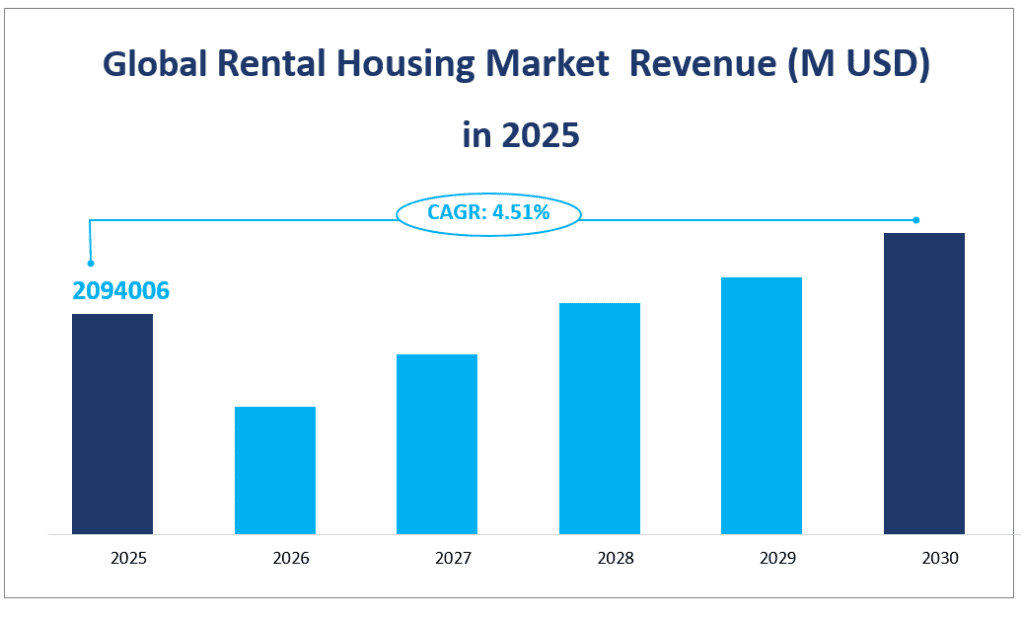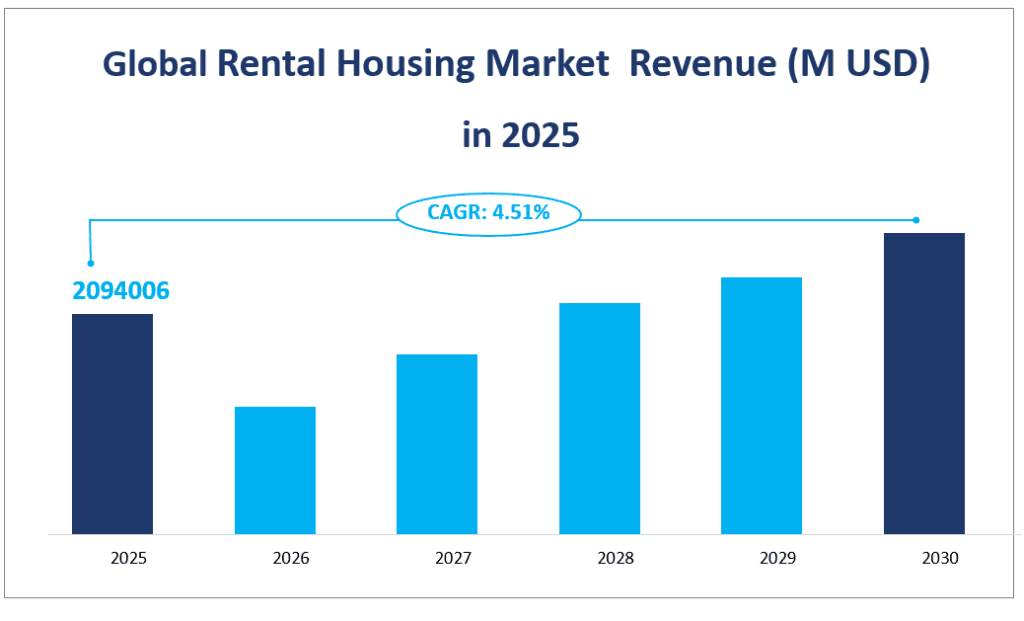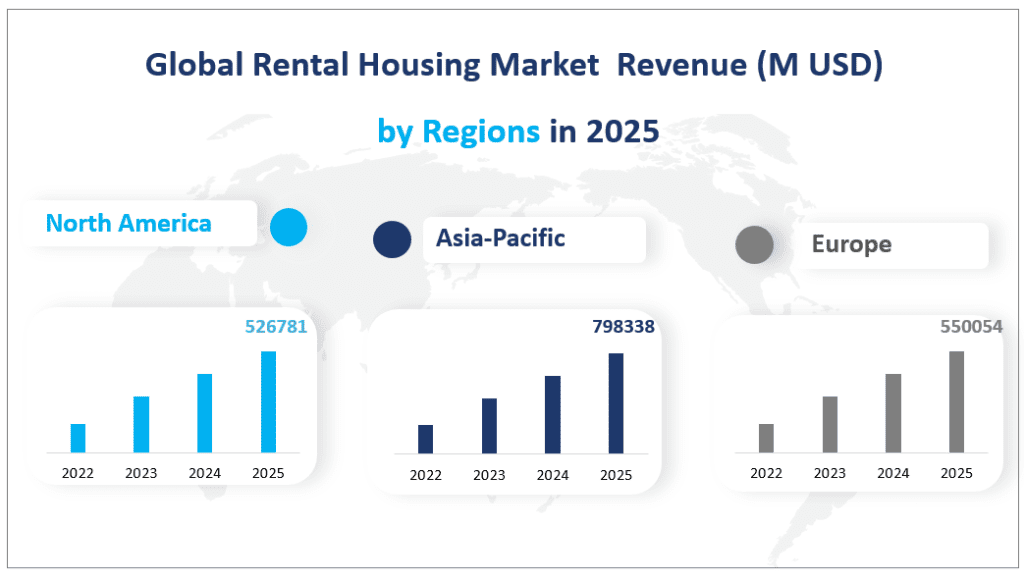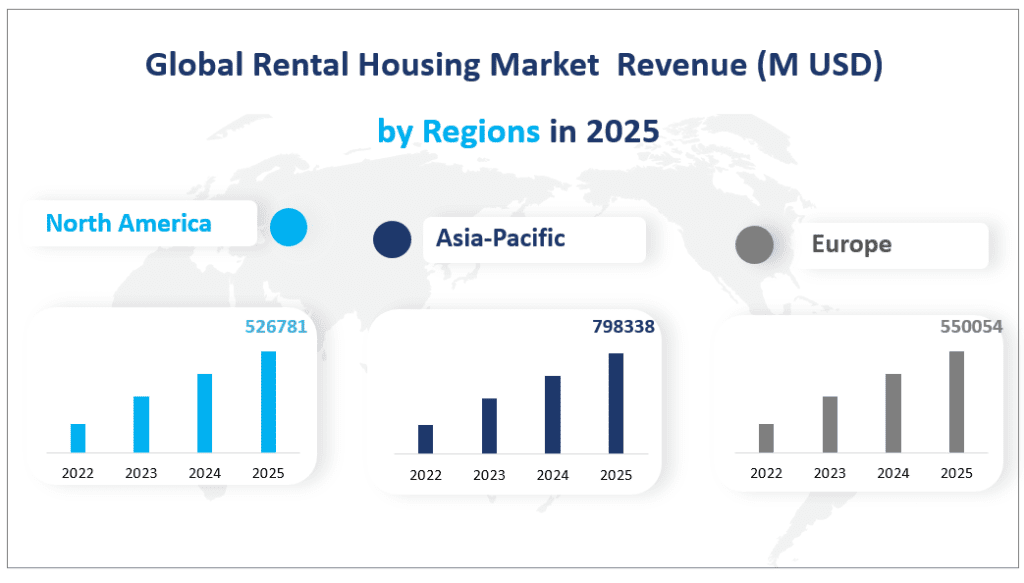1. Global Rental Housing Market Definition
The global rental housing market revenue is projected to reach $2,094,006 million in 2025 with a CAGR of 4.51% from 2025 to 2030.
The rental housing market can be segmented by types, applications, and regions. The two primary types are long-term rentals, which typically last more than six months, and short-term rentals, often used for temporary stays. Long-term rentals are characterized by relatively stable occupancy rates and are popular for residential purposes, while short-term rentals are more common in the hospitality and tourism sectors.
Global Rental Housing Market Revenue (M USD) in 2025


2. Driving Factors of Rental Housing Market
Urbanization and Population Growth: The increasing trend of urbanization, particularly in developing countries, has led to a higher demand for rental housing. As more people move to cities for work and education, the need for affordable and accessible housing options grows. This trend is especially pronounced in regions like Asia-Pacific and South America, where rapid urban development is driving market expansion.
Changing Lifestyle Preferences: Modern lifestyles, characterized by mobility and flexibility, have increased the preference for rental housing. Millennials and younger generations, in particular, are more inclined to rent rather than buy, driven by factors such as job mobility, lifestyle choices, and financial considerations. This shift in preference has significantly boosted the rental housing market.
Technological Advancements: The rise of online platforms and digital tools has made it easier for landlords and tenants to connect. These platforms provide transparency, convenience, and a broader range of options for both parties. The integration of technology in property management has also improved efficiency and reduced operational costs.
Government Policies: Governments in various regions are implementing policies to support the rental housing market. Initiatives such as affordable housing programs, tax incentives for landlords, and regulations to protect tenants’ rights are fostering a favorable environment for market growth.
3. Limiting Factors of Rental Housing Market
Regulatory Challenges: Stringent regulations and zoning laws can pose challenges to the rental housing market. These regulations may limit the availability of land for new developments, increase construction costs, and impose restrictions on rental prices. Such constraints can hinder the market’s ability to meet the growing demand for rental properties.
Economic Uncertainty: Economic downturns and fluctuations in the job market can impact the rental housing market. During economic crises, tenants may face financial difficulties, leading to higher vacancy rates and reduced rental income for landlords. Additionally, economic instability can deter investors from entering the market, limiting the supply of rental properties.
Housing Affordability: In many regions, the cost of living and housing is rising faster than wages. This disparity can make it difficult for potential renters to afford suitable housing, leading to a mismatch between supply and demand. High rental prices can also discourage long-term tenancies, affecting the stability of the rental market.
Competition from Homeownership: In some regions, government policies and market conditions may favor homeownership over renting. Mortgage subsidies, tax benefits, and social perceptions can encourage individuals to buy homes rather than rent, reducing the demand for rental properties.
4. Rental Housing Market Segment
Product Types
The long-term rental segment is projected to generate a revenue of $1,302,937 million in 2025. This type holds the majority of the market share, accounting for approximately 62.22% of the total rental housing market. Long-term rentals are typically leases that last for more than six months. They are popular among individuals and families seeking stable housing solutions. These rentals often come with amenities and services tailored to long-term living, such as fully furnished apartments, community facilities, and personalized attention from property management.
The short-term rental segment is expected to achieve a revenue of $791,069 million in 2025. Short-term rentals hold a market share of around 37.78%, making them a significant but smaller portion of the rental housing market compared to long-term rentals. Short-term rentals are designed for temporary stays, often lasting less than six months. They are popular among travelers, business professionals on short assignments, and individuals in transition. These rentals are typically furnished and offer flexible lease terms, making them ideal for short-term accommodation needs.
The long-term rental segment holds the largest market share in the global rental housing market, driven by the demand for stable and long-lasting housing solutions. However, the short-term rental segment is growing at a slightly faster rate, indicating a rising demand for flexible and temporary accommodation options.
Analysis of Different Applications
The household rental segment is projected to generate a revenue of $1,132,826 million in 2025. This application holds the majority of the market share, accounting for approximately 54.10% of the total rental housing market. Household rentals are designed for residential purposes, catering to individuals and families seeking places to live. These rentals are typically unfurnished or semi-furnished and are located in residential areas. They are driven by the need for stable housing and are influenced by factors such as population growth, urbanization, and changing lifestyle preferences.
The commercial rental segment is expected to achieve a revenue of $961,179 million in 2025. Commercial rentals hold a market share of around 45.90%, making them a significant portion of the rental housing market. Commercial rentals include properties such as office buildings, warehouses, and retail spaces. These rentals are driven by business needs and economic conditions. They are influenced by factors such as economic growth, business expansion, and the demand for commercial real estate in urban areas.
The household rental application holds the largest market share in the global rental housing market, driven by the need for residential housing solutions. However, both household and commercial rentals are growing at a robust pace, indicating a strong demand for both residential and commercial properties in the rental housing market.
Market Revenue by Segment
| Market Revenue (M USD) in 2025 | ||
| By Type | Long-term Rental | 1302937 |
| Short-term Rental | 791069 | |
| By Application | Household | 1132826 |
| Commercial | 961179 |
5. Regional Rental Housing Market
The North American rental housing market is projected to generate a revenue of $526,781 million. This region includes the United States, Canada, and Mexico, with the United States being the dominant market. The market is characterized by a high demand for both long-term and short-term rentals, driven by urbanization and a preference for flexible living arrangements. This region offers a mix of long-term and short-term rental options, catering to a wide range of tenant needs.
The European rental housing market is projected to generate a revenue of $550,054 million. Europe’s market is diverse, with significant contributions from countries like Germany, the UK, France, and Italy. The region is known for its stable rental market, driven by strong demand in urban areas and a preference for long-term leases. This region’s market is characterized by a preference for long-term leases and a stable demand in urban centers.
The Asia-Pacific rental housing market is projected to generate a revenue of $798,338 million. This region includes China, Japan, South Korea, Australia, and India, with China being the dominant market. The Asia-Pacific region is experiencing rapid urbanization and population growth, driving a significant demand for rental housing. This region’s rapid urbanization and population growth are driving a strong demand for both long-term and short-term rental options.
The South American rental housing market is projected to generate a revenue of $117,304 million. This region includes Brazil, Argentina, Colombia, and Chile, with Brazil being the dominant market. The market is characterized by a growing demand for rental housing, driven by economic development and urbanization. This region’s market is growing steadily, driven by economic development and increasing urbanization.
The Middle East & Africa rental housing market is projected to generate a revenue of $101,528 million. This region includes Saudi Arabia, the UAE, Egypt, Nigeria, and South Africa, with Saudi Arabia being the dominant market. The market is characterized by a growing demand for rental housing, driven by economic growth and urbanization. This region’s market is growing steadily, driven by economic growth and increasing urbanization.
The Asia-Pacific region holds the largest market share. This region’s rapid urbanization and population growth are driving significant demand for rental housing. he Asia-Pacific region is also the fastest-growing, with a CAGR of 8.00% from 2020 to 2026. This growth is driven by economic development, urbanization, and increasing demand for both long-term and short-term rental options.
Global Rental Housing Market Revenue (M USD) by Regions in 2025


6. Top 3 Companies in the Global Rental Housing Market
Introduction and Business Overview: Greystar Real Estate Partners is a global leader in rental housing, offering expertise in real estate sectors across multiple geographies. Founded in 1993, Greystar specializes in owning, operating, and developing collegiate, multifamily, corporate, and senior housing.
Products: Greystar provides a wide range of rental housing options, including long-term and short-term leases. Their properties are known for their desirable locations, quality services, and personalized attention to tenants.
Introduction and Business Overview: CBRE Group is the world’s largest commercial real estate services and investment firm. Established in 1906, CBRE offers a broad range of integrated services, including property management, investment management, and strategic consulting.
Products: CBRE provides advisory and transaction services for office, industrial, and retail properties. They also offer property leasing, strategic consulting, and development services.
Introduction and Business Overview: Lincoln Property Company is a leading developer of office buildings and residential apartment complexes in the United States. Founded in 1965, the company specializes in high-rise office towers and luxury apartments.
Products: Lincoln Property Company offers rental housing services, focusing on providing comfortable and convenient living options for tenants. They are known for their high-quality properties and excellent customer service.
In 2020, Lincoln Property Company’s rental housing revenue was $279.1 million.
Major Players
| Company Name | Sales Regions |
| Greystar Real Estate Partners | Worldwide |
| CBRE Group | Worldwide |
| Lincoln Property Company | Worldwide |
| Pinnacle | Mainly in Americas |
| Equity Residential | Mainly in Americas |
| Colliers International | Mainly in Americas, APAC, Europe, and Middle East & Africa |
| FPI Management | Mainly in Americas |
| WinnCompanies | Mainly in Americas |
| MAA | Mainly in Americas |
| Apartment Management Consultants, LLC | Mainly in Americas |
| BH Management, LLC | Mainly in Americas |
| 5I5J | Mainly in China and Americas |
| Savills plc | Worldwide |
| Vanke | Mainly in Asia |
| Longfor | Mainly in China |
| Knight Frank LLP | Worldwide |
1 Rental Housing Market Overview
1.1 Product Overview and Scope of Rental Housing
1.2 Classification of Rental Housing by Type
1.2.1 Global Rental Housing Revenue Comparison by Type (2014-2026)
1.2.2 Global Rental Housing Revenue Market Share by Type in 2019
1.2.3 Long-term Rental
1.2.4 Short-term Rental
1.3 Global Rental Housing Market by Applications
1.3.1 Household
1.3.2 Commercial
1.4 Global Rental Housing Market by Regions
1.4.1 North America (2014-2026)
1.4.2 Europe (2014-2026)
1.4.3 Asia-Pacific (2014-2026)
1.4.4 South America (2014-2026)
1.4.5 Middle East and Africa (2014-2026)
1.5 Global Market Size of Rental Housing (2014-2026)
1.6 Mexico Rental Housing Market Analysis
1.6.1 Mexico Rental Housing Market Analysis by Type
1.6.2 Mexico Rental Housing Market Analysis by Applications
2 Providers Profiles
2.1 Greystar Real Estate Partners
2.1.1 Business Overview
2.1.2 Products Analysis
2.1.3 Greystar Real Estate Partners Rental Housing Revenue, Gross Margin
2.2 CBRE Group
2.2.1 Business Overview
2.2.2 Products Analysis
2.2.3 CBRE Group Rental Housing Revenue, Gross Margin
2.3 Lincoln Property Company
2.3.1 Business Overview
2.3.2 Products Analysis
2.3.3 Lincoln Property Company Rental Housing Revenue, Gross Margin
2.4 Pinnacle
2.4.1 Business Overview
2.4.2 Products Analysis
2.4.3 Pinnacle Rental Housing Revenue, Gross Margin
2.5 Equity Residential
2.5.1 Business Overview
2.5.2 Products Analysis
2.5.3 Equity Residential Rental Housing Revenue, Gross Margin
2.6 Colliers International
2.6.1 Business Overview
2.6.2 Products Analysis
2.6.3 Colliers International Rental Housing Revenue, Gross Margin
2.7 FPI Management
2.7.1 Business Overview
2.7.2 Products Analysis
2.7.3 FPI Management Rental Housing Revenue, Gross Margin
2.8 WinnCompanies
2.8.1 Business Overview
2.8.2 Products Analysis
2.8.3 WinnCompanies Rental Housing Revenue, Gross Margin
2.9 MAA
2.9.1 Business Overview
2.9.2 Products Analysis
2.9.3 MAA Rental Housing Revenue, Gross Margin
2.10 Apartment Management Consultants, LLC
2.10.1 Business Overview
2.10.2 Products Analysis
2.10.3 Apartment Management Consultants, LLC Rental Housing Revenue, Gross Margin
2.11 BH Management, LLC
2.11.1 Business Overview
2.11.2 Products Analysis
2.11.3 BH Management, LLC Rental Housing Revenue, Gross Margin
2.12 5I5J
2.12.1 Business Overview
2.12.2 Products Analysis
2.12.3 5I5J Rental Housing Revenue, Gross Margin
2.13 Savills plc
2.13.1 Business Overview
2.13.2 Products Analysis
2.13.3 Savills plc Rental Housing Revenue, Gross Margin
2.14 Vanke
2.14.1 Business Overview
2.14.2 Products Analysis
2.14.3 Vanke Rental Housing Revenue, Gross Margin
2.15 Longfor
2.15.1 Business Overview
2.15.2 Products Analysis
2.15.3 Longfor Rental Housing Revenue, Gross Margin
2.16 Knight Frank LLP
2.16.1 Business Overview
2.16.2 Products Analysis
2.16.3 Knight Frank LLP Rental Housing Revenue, Gross Margin
3 Global Rental Housing Market Competition, by Players
3.1 Global Rental Housing Revenue and Share by Players (2014-2020)
3.2 Market Concentration Rate
3.2.1 Top 3 Rental Housing Players Market Share
3.2.2 Top 6 Rental Housing Players Market Share
4 Global Rental Housing Market Size by Regions
4.1 Global Rental Housing Revenue and Market Share by Regions
4.2 North America Rental Housing Revenue and Growth Rate (2014-2020)
4.3 Europe Rental Housing Revenue and Growth Rate (2014-2020)
4.4 Asia-Pacific Rental Housing Revenue and Growth Rate (2014-2020)
4.5 South America Rental Housing Revenue and Growth Rate (2014-2020)
4.6 Middle East and Africa Rental Housing Revenue and Growth Rate (2014-2020)
5 North America Rental Housing Revenue by Countries
5.1 North America Rental Housing Revenue by Countries (2014-2020)
5.2 United States Rental Housing Revenue and Growth Rate (2014-2020)
5.3 Canada Rental Housing Revenue and Growth Rate (2014-2020)
5.4 Mexico Rental Housing Revenue and Growth Rate (2014-2020)
6 Europe Rental Housing Revenue by Countries
6.1 Europe Rental Housing Revenue by Countries (2014-2020)
6.2 Germany Rental Housing Revenue and Growth Rate (2014-2020)
6.3 UK Rental Housing Revenue and Growth Rate (2014-2020)
6.4 France Rental Housing Revenue and Growth Rate (2014-2020)
6.5 Italy Rental Housing Revenue and Growth Rate (2014-2020)
6.6 Spain Rental Housing Revenue and Growth Rate (2014-2020)
6.7 Russia Rental Housing Revenue and Growth Rate (2014-2020)
7 Asia-Pacific Rental Housing Revenue by Countries
7.1 Asia-Pacific Rental Housing Revenue by Countries (2014-2020)
7.2 China Rental Housing Revenue and Growth Rate (2014-2020)
7.3 Japan Rental Housing Revenue and Growth Rate (2014-2020)
7.4 South Korea Rental Housing Revenue and Growth Rate (2014-2020)
7.5 Australia Rental Housing Revenue and Growth Rate (2014-2020)
7.6 India Rental Housing Revenue and Growth Rate (2014-2020)
7.7 Taiwan Rental Housing Revenue and Growth Rate (2014-2020)
7.8 Indonesia Rental Housing Revenue and Growth Rate (2014-2020)
8 South America Rental Housing Revenue by Countries
8.1 South America Rental Housing Revenue by Countries (2014-2020)
8.2 Brazil Rental Housing Revenue and Growth Rate (2014-2020)
8.3 Argentina Rental Housing Revenue and Growth Rate (2014-2020)
8.4 Columbia Rental Housing Revenue and Growth Rate (2014-2020)
8.5 Chile Rental Housing Revenue and Growth Rate (2014-2020)
9 Middle East and Africa Revenue Rental Housing by Countries
9.1 Middle East and Africa Rental Housing Revenue by Countries (2014-2020)
9.2 Saudi Arabia Rental Housing Revenue and Growth Rate (2014-2020)
9.3 UAE Rental Housing Revenue and Growth Rate (2014-2020)
9.4 Egypt Rental Housing Revenue and Growth Rate (2014-2020)
9.5 Nigeria Rental Housing Revenue and Growth Rate (2014-2020)
9.6 South Africa Rental Housing Revenue and Growth Rate (2014-2020)
10 Global Rental Housing Market Segment by Type
10.1 Global Rental Housing Revenue and Market Share by Type (2014-2020)
10.2 Global Rental Housing Market Forecast by Type (2020-2026)
10.3 Long-term Rental Revenue Growth Rate
10.4 Short-term Rental Revenue Growth Rate
11 Global Rental Housing Market Segment by Applications
11.1 Global Rental Housing Revenue Market Share by Applications (2014-2020)
11.2 Rental Housing Market Forecast by Applications (2020-2026)
11.3 Household Revenue Growth Rate (2014-2026)
11.4 Commercial Revenue Growth Rate (2014-2026)
12 Global Rental Housing Market Size Forecast (2020-2026)
12.1 Global Rental Housing Market Size Forecast (2020-2026)
12.2 Global Rental Housing Market Forecast by Regions (2020-2026)
12.3 North America Rental Housing Revenue Market Forecast (2020-2026)
12.4 Europe Rental Housing Revenue Market Forecast (2020-2026)
12.5 Asia-Pacific Rental Housing Revenue Market Forecast (2020-2026)
12.6 South America Rental Housing Revenue Market Forecast (2020-2026)
12.7 Middle East and Africa Rental Housing Revenue Market Forecast (2020-2026)
13 Appendix
13.1 Methodology
13.2 Research Data Source
